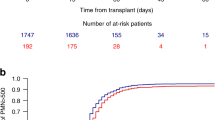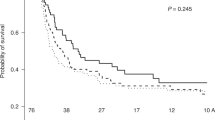Abstract
Engraftment outcomes following autologous transplantation correlate poorly to infused stem cell number. We evaluated 446 consecutive patients who underwent autologous transplantation at our centre between 2001 and 2012. The impact of pre-transplant and collection factors together with CD34+ dosing ranges on engraftment, hospital length of stay (LOS) and survival endpoints were assessed in order to identify factors which might be optimized to improve outcomes for patients undergoing autologous transplantation using haemopoietic progenitor cells–apheresis (HPC-A). Infused CD34+ cell dose correlated to platelet but not neutrophil recovery. Time to platelet engraftment was significantly delayed in those receiving low versus medium or high CD34+ doses. Non-remission status was associated with slower neutrophil and platelet recovery. Increasing neutrophil contamination of HPC-A was strongly associated with slower neutrophil recovery with infused neutrophil dose/kg recipient body weight ≥3 × 108/kg having a significant impact on time to neutrophil engraftment (p = 0.001). Higher neutrophil doses/kg in HPC-A were associated with days of granulocyte colony stimulation factor (G-CSF) use, HPC-A volumes >500 ml and higher NCC in HPC-A. High infused neutrophil dose/kg and age >65 years were associated with longer hospital LOS (p = 0.002 and 0.011 respectively). Only age, disease and disease status predicted disease-free survival (DFS) and overall survival (OS) in our cohort (p < 0.005). Non-relapse mortality was not affected by low dose of CD34+ (<2 × 106/kg). In conclusion, our study shows that CD34+ remains a useful and convenient marker for assessing haemotopoietic stem cell content and overall engraftment capacity post-transplant. Neutrophil contamination of HPC-A appears to be a key factor delaying neutrophil recovery. Steps to minimize the degree of neutrophil contamination in HPC-A product may be associated with more rapid neutrophil engraftment and reduced hospital LOS.


Similar content being viewed by others
References
Allan DS, Keeney M, Howson-Jan K, Popma J, Weir K, Bhatia M, Sutherland DR, Chin-Yee IH (2002) Number of viable CD34+ cells reinfused predicts engraftment in autologous hematopoietic stem cell transplantation. Bone Marrow Transplant 29:967–972
Weaver CH, Hazelton B, Birch R, Palmer P, Allen C, Schwartzberg L, West W (1995) An analysis if engraftment kinetics as a function of the CD34 content of peripheral blood progenitor cell collections in 692 patients after the administration of myeloablative chemotherapy. Blood 86:3961–3969
Siena S, Bregni M, Brando B, Belli N, Lansdorp PM, Bonadonna G, Gianni M (1991) Flow cytometry to estimate circulating hematopoietic progenitors for autologous transplantation: comparative analysis of different CD34 monoclonal antibodies. Haematologica 76:330–333
Haas R, Möhle R, Frühauf S, Goldschmidt H, Witt B, Flentje M, Wannenmacher M, Hunstein W (1994) Patient characteristics associated with successful mobilizing and autografting of peripheral blood progenitor cells in malignant lymphoma. Blood 83:3787–3794
Kiss JE, Rybka WB, Winkelstein A, deMagalhaes-Silverman M, Lister J, D'Andrea P, Ball ED (1997) Relationship of CD34+ cell dose to early and late hematopoiesis following autologous peripheral blood stem cell transplantation. Bone Marrow Transplant 19:303–310
Papadopoulos KP, Ayello J, Tugulea S, Heitjan DF, Williams C, Reiss RF, Reiss RF, Vahdat LT, Suciu-Foca N, Antman KH, Hesdorffer CS (1997) Harvest quality and factors affecting collection and engraftment of CD34+ cells in patients with breast cancer scheduled for high-dose chemotherapy and peripheral blood progenitor cell support. J Hematother 6:61–68
Lanza F, Campioni DC, Hellmann A, Milone G, Wahlin A, Walewski J, Spedini P, Fiamenghi C, Cuneo A, Knopińska W, Swierkowska-Czeneszew M, Petriz J, Fruehauf S, Farge D, Mohty M, Passweg J, Ruuto T, Madrigal A, Johnsen HE, Quality assessment of haematopoietic stem cell grafting committee of European Blood and Marrow Transplantation Society (2013) Individual quality assessment of autografting by probability estimation for clinical endpoints: a prospective validation study from the European group for blood and marrow transplantation. Biol Blood Marrow Transplant 19:1670–1676
Shpall EJ, Champlin R, Glaspy JA (1998) Effect of CD34+ peripheral blood progenitor cell dose on hematopoietic recovery. Biol Blood Marrow Transplant 4:84–92
Sutherland DR, Keating A, Nayar R, Anania S, Stewart AK (1994) Sensitive detection and enumeration of CD34+ cells in peripheral and cord blood by flow cytometry. Exp Hematol 22:1003–1010
Gratama JW, Kraan J, Keeney M, Sutherland DR, Granger V, Barnett D (2003) Validation of the single-platform ISHAGE method for CD34 (+) hematopoietic stem and progenitor cell enumeration in an international multicenter study. Cytotherapy 5:55–65
Sartor M, Antonenas V, Garvin F, Webb M, Bradstock KF (2005) Recovery of viable CD34+ cells from cryopreserved hemopoietic progenitor cell products. Bone Marrow Transplant 36:199–204
Bensinger W, Appelbaum F, Rowley S, Storb R, Sanders J, Lilleby K et al (1995) Factors that influence collection and engraftment of autologous peripheral-blood stem cells. J Clin Oncol 13:2547–2555
Olivieri A, Offidani M, Montanari M, Ciniero L, Cantori I, Ombrosi L, Masia CM, Centurioni R, Mancini S, Brunori M, Leoni P (1998) Factors affecting hemopoietic recovery after high-dose therapy and autologous peripheral blood progenitor cell transplantation: a single center experience. Haematologica 83:329–337
Ketterer N, Salles G, Raba M, Espinouse D, Sonet A, Tremisi P, Dumontet C, Moullet I, Eljaafari-Corbin A, Neidhardt-Berard EM, Bouafia F, Coiffier B (1998) High CD34(+) cell counts decrease hematologic toxicity of autologous peripheral blood progenitor cell transplantation. Blood 9:3148–3155
Abrahamsen JF, Wentzel-Larsen T, Bruserud O (2004) Autologous transplantation: the viable transplanted CD34+ cell dose measured post-thaw does not predict engraftment kinetics better than the total CD34+ cell dose measured pre-freeze in patients that receive more than 2x10(6) CD34+ cells/kg. Cytotherapy 6:356–362
Jansen J, Thompson JM, Dugan MJ, Nolan P, Wiemann MC, Birhiray R, Henslee-Downey PJ, Akard LP (2002) Peripheral blood progenitor cell transplantation. Ther Apher 6:5–14
Hicks C, Wong R, Manoharan A, Kwan YL (2007) Viable CD34+/CD133+ blood progenitor cell dose as a predictor of haematopoietic engraftment in multiple myeloma patients undergoing autologous peripheral blood stem cell transplantation. Ann Hematol 86:591–598
Lefrère F, Delarue R, Somme D, Levy V, Damaj G, Tu A, Porcher R, Audat F, Boulat C, Cavazzana-Calvo M, Buzyn A, Belanger C, Maillard N, Hermine O, Varet B (2002) High-dose CD34+ cells are not clinically relevant in reducing cytopenia and blood component consumption following myeloablative therapy and peripheral blood progenitor cell transplantation as compared with standard dose. Transfusion 42:443–450
Hess DA, Wirthlin L, Craft TP, Herrbrich PE, Hohm SA, Lahey R, Eades WC, Creer MH, Nolta JA (2006) Selection based on CD133 and high aldehyde dehydrogenase activity isolates long-term reconstituting human hematopoietic stem cells. Blood 107:2162–2169
Lioznov MV, Freiberger P, Kröger N, Zander AR, Fehse B (2005) Aldehyde dehydrogenase activity as a marker for the quality of hematopoietic stem cell transplants. Bone Marrow Transplant 35:909–914
Christ O, Lucke K, Imren S, Leung K, Hamilton M, Eaves A (2007) Improved purification of hematopoietic stem cells based on their elevated aldehyde dehydrogenase activity. Haematologica 92:1165–1172
Foïs E, Desmartin M, Benhamida S, Xavier F, Vanneaux V, Rea D, Fermand J-P, Arnulf B, Mounier N, Ertault M, Lotz J-P, Galicier L, Raffoux E, Benbunan M, Marolleau J-P, Larghero J (2007) Recovery, viability and clinical toxicity of thawed and washed haematopoietic progenitor cells: analysis of 952 autologous peripheral blood stem cell transplantations. Bone Marrow Transplant 40:831–835
Rowley SD (1992) Techniques of bone marrow and stem cells cryopreservation and storage. In: Sacher RA, Aubuchon JP (eds) Marrow transplantation: practice and technical aspects of stem cells reconstitution. American Association of Blood Banks, Bethesda, pp 105–127
Miller CB, Piantadosi S, Vogelsang GB, Marcellus DC, Grochow L, Kennedy MJ, Jones RJ (1996) Impact of age on outcome of patients with cancer undergoing autologous bone marrow transplant. J Clin Oncol 14:1327–1332
Olivieri A, Marchetti M, Lemoli R, Tarella C, Iacone A, Lanza F, Rambaldi A, Bosi A (2012) Proposed definition of 'poor mobilizer' in lymphoma and multiple myeloma: an analytic hierarchy process by ad hoc working group Gruppo ItalianoTrapianto di Midollo Osseo. Bone Marrow Transplant 47:342–351
Micallef IN, Apostolidis J, Rohatiner AZ, Wiggins C, Crawley CR, Foran JM, Leonhardt M, Bradburn M, Okukenu E, Salam A, Matthews J, Cavenagh JD, Gupta RK, Lister TA (2000) Factors which predict unsuccessful mobilisation of peripheral blood progenitor cells following G-CSF alone in patients with non-Hodgkin's lymphoma. Hematol J 1:367–373
Kuittinen T, Nousiainen T, Halonen P, Mahlamäki E, Jantunen E (2004) Prediction of mobilisation failure in patients with non-Hodgkin’s lymphoma. Bone Marrow Transplant 33:907–912
Stiff PJ, Micallef I, Nademanee AP, Stadtmauer EA, Maziarz RT, Bolwell BJ, Bridger G, Marulkar S, Hsu FJ, Dipersio JF (2011) Transplanted CD34+ cells dose is associated with long-term platelet count recovery following autologous peripheral blood stem cell transplant in patients with Non-Hodgkin Lymphoma or Multiple Myeloma. Biol Blood Marrow Transplant 17:1146–1153
Gratwohl A, Brand R, Niederwieser D, Baldomero H, Chabannon C, Cornelissen J, de Witte T, Ljungman P, McDonald F, McGrath E, Passweg J, Peters C, Rocha V, Slaper-Cortenbach I, Sureda A, Tichelli A, Apperley J (2011) Introduction of a quality management system and outcome after hematopoietic stem-cell transplantation. J Clin Oncol 29:1980–1986
Acknowledgments
We would like to thank our clinical colleagues Dr Chris Arthur, Dr Keith Fay, Dr Luke Coyle, Dr William Stevenson, Dr Naomi Mackinlay and Dr Stephen Mulligan for their helpful input and contribution to patient data, Dr Tom Kennedy and Dr Poomahal Kumar for providing flow cytometry data and Mr David Collins, Ms Cleo Trilivas and Ms Sally Szeto for apheresis data.
Conflict of interest
The authors declare no conflict of interest.
Author information
Authors and Affiliations
Corresponding author
Rights and permissions
About this article
Cite this article
Bai, L., Xia, W., Wong, K. et al. Factors predicting haematopoietic recovery in patients undergoing autologous transplantation: 11-year experience from a single centre. Ann Hematol 93, 1655–1664 (2014). https://doi.org/10.1007/s00277-014-2112-2
Received:
Accepted:
Published:
Issue Date:
DOI: https://doi.org/10.1007/s00277-014-2112-2




